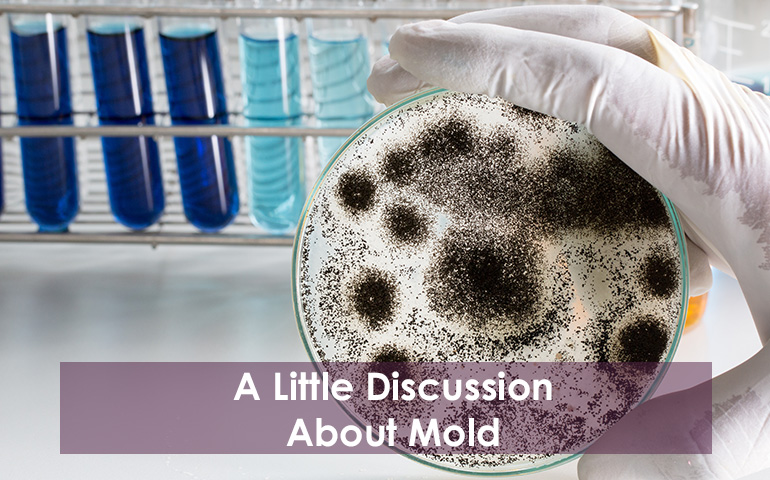
A Little Discussion About Mold
by Chris Petry
Valentine’s Day is right around the corner and if you’re anything like me, you’ll likely spend the day obsessing over the discovery of mold under a loose wet tile in your basement. Or maybe not. You could be going out to dinner with your sweetheart or something. This week’s topic, however, deals with the former possibility.
Just what is mold, anyway? Mold is a type of multicellular fungus that aids in the decay of organic matter. It tends to develop most frequently in cool damp environments, its existence dependent merely on the presence of oxygen and water, and reproduces through the aid of microscopic spores. Molds are a crucial part of the ecosystem, cleansing the forest floor of decaying leaves, for example. Think of it like nature’s own private landscaper. Truth is, Molds grow inside and out, every time of year, and in every environmental variation you can think of. It’s worth repeating: as long as you have air and water, you have the possibility of mold.
Many times, when we think of mold, we think of ominous black mold strains like Stachybotrys (which I swear shows up as a culprit in every third episode of Forensic Files) or the fluffy green variety that might adorn the leftover casserole you kept meaning to throw out, but forgot. Mold in and of itself, is not intrinsically destructive. Certain strains can cause respiratory complications, particularly in infants and those with underdeveloped or weakened lungs. That said, the drug penicillin is an antibiotic derived from the namesake mold, used in medicine to treat a number of bacterial infections. If you enjoy truffles, cheese, wine, or yogurt, you’re the beneficiary of the hard work of numerous species of mold. Sorry to ruin that Valentine’s dinner.
Where might homeowners discover mold? Let’s say it again: almost anywhere you find air and moisture. That means you’re most likely to detect mold in basements, on concrete walls and floors, in ventilation, laundry rooms, bathrooms, garages and window seals. To prevent the accumulation or spread of mold:

f you spot mold, clean the problem areas with vinegar or bleach. Be sure to wear gloves and an N95-style mask to avoid chemical burns or the inhalation of fumes, of course.

Schedule yearly inspections and cleanings of your home’s HVAC unit.

Fix suspected water leaks.

Reseal windows and doors.

Reduce the humidity in your home.

Ventilate damp rooms, preferably funneling the moisture outside the home.

Place air purifiers in areas susceptible to moisture.
If you should discover mold, don’t freak out. The CDC has the reassuring news that, “There are very few reports that toxigenic molds found inside homes can cause unique or rare health conditions such as pulmonary hemorrhage or memory loss.” Just clean it up using the above-mentioned cleaning regimen, or better still, consult a professional cleaner who can do a better job both identifying the strain of mold you’re dealing with and removing it.





